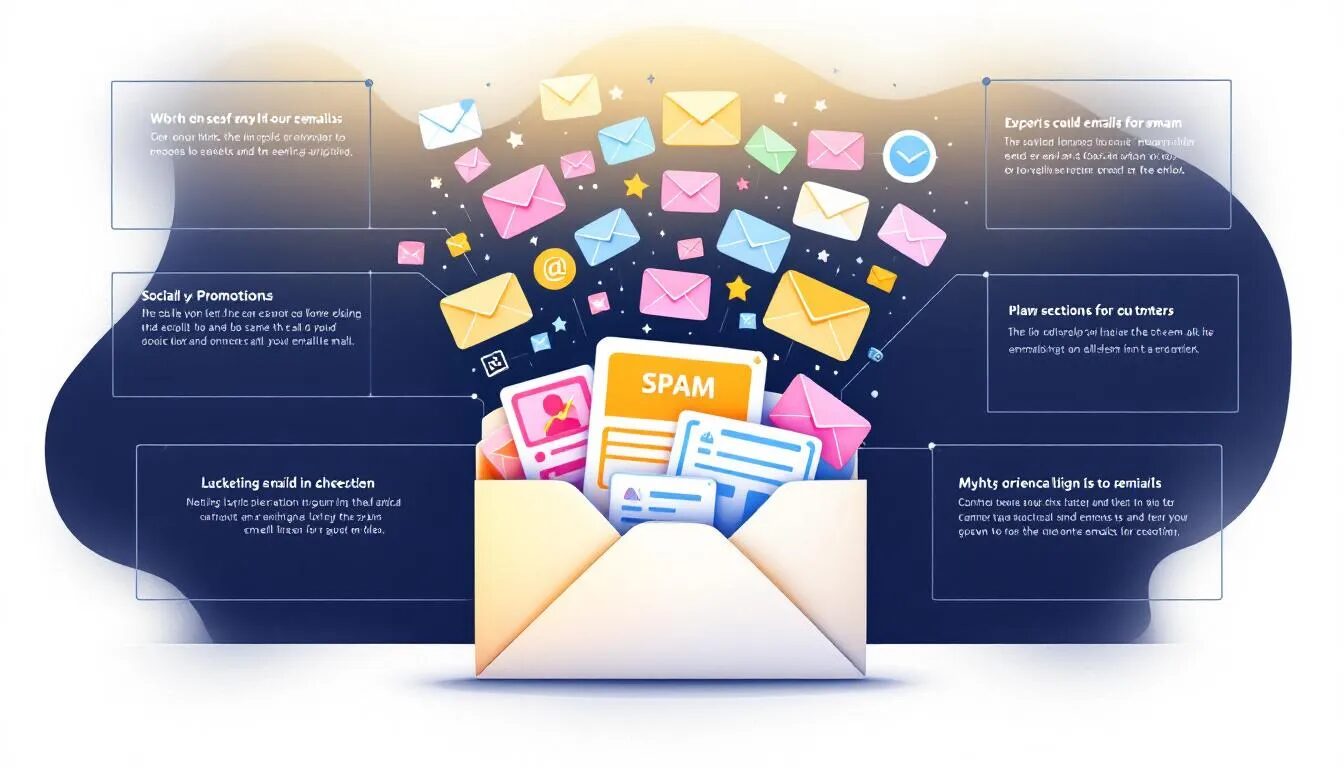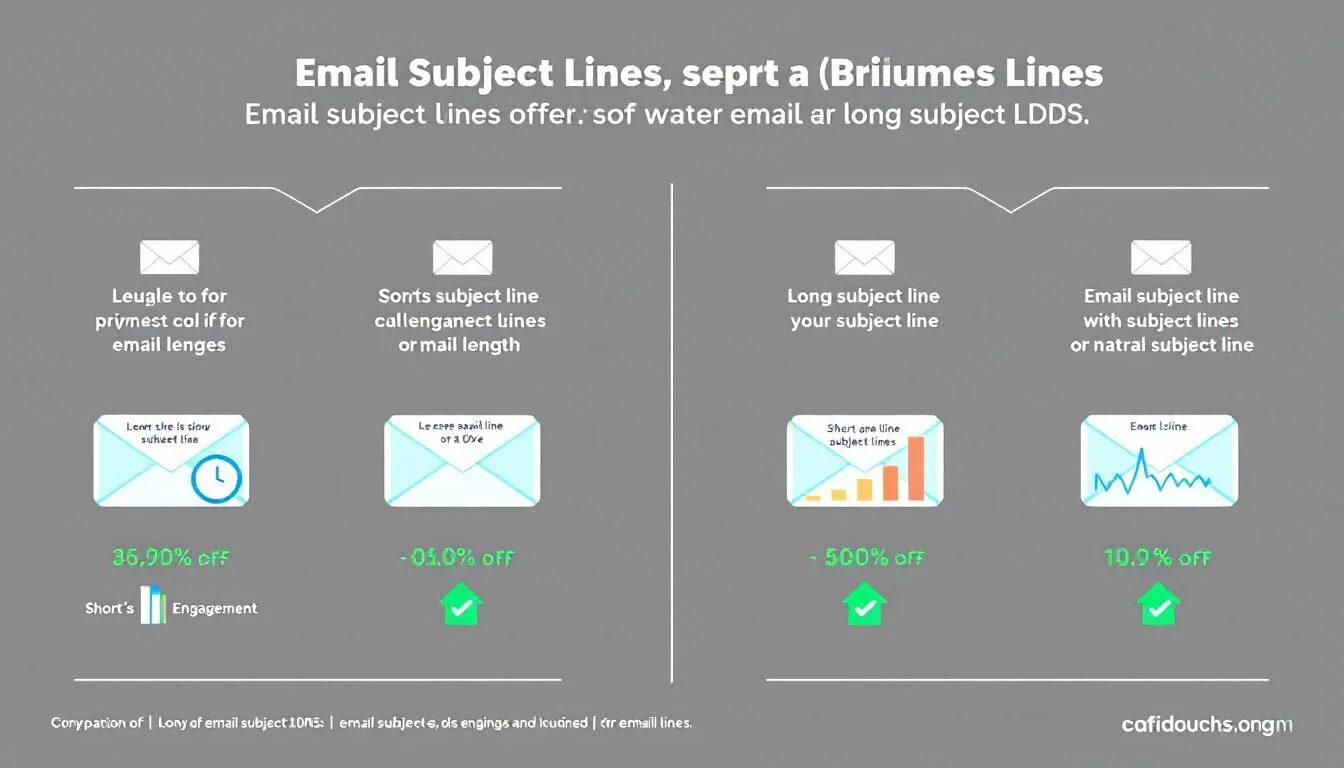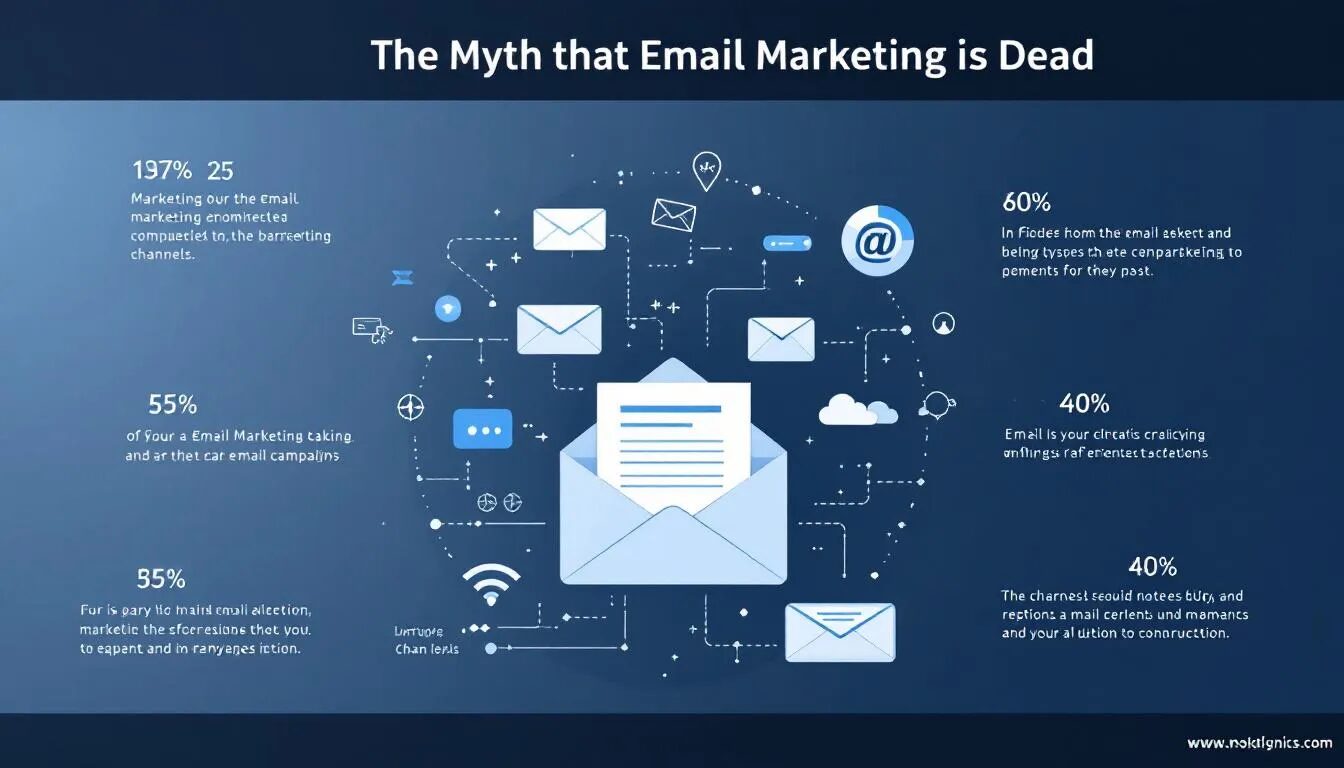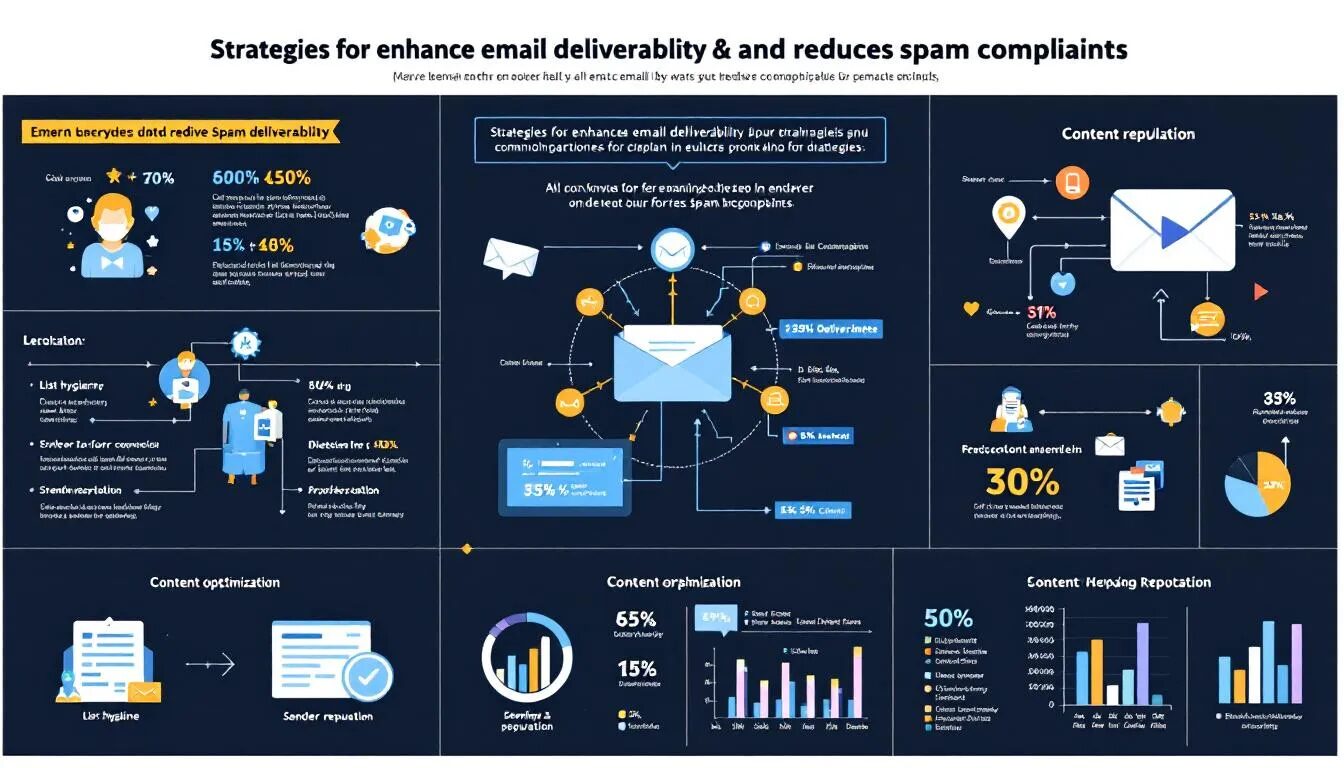
The Truth About Email Marketing Myths That Are Costing You Sales
Are email marketing myths that are costing you sales? One common email marketing myth is that following rigid rules about timing or subject lines guarantees success, but these beliefs often overlook the importance of personalization and data-driven strategies. Uncover the truth behind common myths affecting your email campaigns. Learn about misconceptions on timing, content, and subject lines, and find out how to optimize your email marketing for better results—because even with new digital channels, email remains one of the most effective ways to reach and engage your audience.
Key Takeaways
- Email timing doesn’t guarantee higher open rates; the relevance of content is more important.
- Modern spam filters focus on sender reputation and engagement, not just trigger words.
- Long emails can engage readers effectively if they deliver valuable and relevant content.
- Debunking email marketing myths can provide a competitive advantage by enabling more effective strategies that outperform competitors.
Myth: Sending Emails at Specific Times Guarantees Higher Open Rates

One of the most pervasive email marketing myths is that sending emails at specific times guarantees higher open rates. While it’s tempting to believe that there is a magic hour when all your subscribers are poised to open your email, the reality is far more complex. Various factors, such as brand reputation, interest in the products, and the relevance of the content, play a significant role in open rates. Recent assessments show that common myths about email timing don’t uniformly perform based on the time sent, as popularity varies with the audience.
Understanding your audience’s preferences and behaviors can significantly impact email open rates. Testing various sending times alongside content value can lead to higher engagement. Analyzing your campaign’s performance will reveal the true impact of timing on engagement, helping you make data-driven decisions. The notion that specific send times guarantee higher open rates is simply a myth.
Timing is Not Everything
The effectiveness of emails is significantly influenced by the relevance of the content, not just the timing of the send. Pertinent and engaging content is key to capturing and retaining recipient interest. The most crucial factor in email effectiveness is delivering relevant content that aligns with the reader’s needs.
Subject lines act as trailers that must spark curiosity and attract clicks. Understanding how your emails appear in the recipient’s inbox—including the subject line, preview text, and sender name—can greatly influence open rates and engagement. Success in email marketing hinges on segmentation, intent signals, and compelling email subject lines rather than just timing.
Experimentation is Key
Experimentation is essential in email marketing as it helps determine what strategies yield the best results. Marketers should conduct experiments with sending times to discover what resonates best with their unique audience. There is no single best time or day to send emails, as engagement can vary widely based on the audience and the content.
Data-driven decisions through A/B testing refine email marketing strategies. After running tests, compare your results to industry benchmarks to identify areas for improvement.
Audience Habits Matter
Understanding your audience’s unique behaviors is essential for improving engagement, including:
- Identifying your target audience to tailor content and improve engagement and campaign effectiveness
- Knowing when they check their emails
- Analyzing unsubscribe data to gain insights into misalignment with the audience
- Using these insights to prompt necessary adjustments in targeting strategies
Understanding the best times to send emails, such as during more relaxing moments for your audience, can enhance engagement rates. Email marketing provides direct access to your audience, allowing for targeted messaging that resonates with their preferences.
Myth: Using Certain Words Sends Your Email to Spam

The belief that using words like ‘free’ automatically sends emails to spam is a common misconception. Modern spam filters assess various factors including sender reputation, engagement, and content quality rather than relying solely on certain trigger words. In reality, spam email refers to any unwanted bulk marketing email sent without the recipient’s consent, while genuine marketing messages are targeted and relevant to the audience. Factors affecting email open rates include the overall quality and relevance of the content provided in the email. Emails with the word ‘free’ are not automatically marked as spam; the overall value and relevance of the content matter more.
Spam filters have become more sophisticated, evaluating sender reputation and engagement metrics such as open and click-through rates to determine email deliverability.
These advancements in spam filtering demand that email marketers prioritize building a good reputation and fostering engagement.
Modern Spam Filters
Modern spam filters evaluate sender reputation, which is crucial for determining email deliverability. Engagement metrics, such as open rates and click-through rates, are now essential components in the spam filtering process.
These advancements in spam filtering demand that email marketers prioritize building a good reputation and fostering engagement.
Focus on Value
Understanding the reader’s mindset is critical for crafting effective email content. Email content should be concise for rushed readers, clear for those who are unsure, and fast for those ready to buy. Focusing on providing valuable content in emails is essential for engagement and retention.
Delivering valuable, tailored content enhances email marketing campaigns.
Sender Reputation
Consistent quality communication helps maintain a positive sender reputation. Emails that elicit responses significantly boost the sender’s standing with email service providers. Sender reputation is crucial for successful email marketing campaigns and can affect deliverability.
Best practices for maintaining a healthy sender reputation include focusing on subscriber engagement and providing valuable content.
Myth: Short Subject Lines Always Perform Better

Subject lines do not have to be short; in fact, longer subject lines can outperform shorter ones when the offer is compelling. The quality and relevance of the email content, including the subject line, are far more important factors than just the length. The belief that shorter subject lines are always more effective is a common myth in email marketing. Effective subject lines should be clear, informative, and engaging, focusing on delivering value rather than adhering to a specific length. In email notifications, clear and informative subject lines are especially important, as they can significantly improve open rates and boost user engagement.
A/B testing emails allows marketers to determine the effectiveness of different strategies. Various aspects should be tested, including from names, subject lines, and preheaders. Some of the best-performing subject lines are intentionally boring or slightly offbeat, as long as they remain relevant.
Subject Line Testing
A/B testing emails allows marketers to determine the effectiveness of different strategies. Various aspects should be tested, including from names, subject lines, and preheaders.
Some of the best-performing subject lines are intentionally boring or slightly offbeat, as long as they remain relevant.
Clarity over Brevity
Avoid clickbait, giving away the whole plot, and being vague just to sound mysterious when creating subject lines to ensure clarity. Clear and informative subject lines are essential for capturing attention and driving engagement in email marketing. This is a wake up call for marketers to refine their approach.
Research shows that clear subject lines often perform better than short, vague ones, leading to higher open rates. Prioritizing clarity in subject lines not only helps in engaging readers but also sets proper expectations for the email content.
Engaging Content
Compelling subject lines that evoke curiosity are likely to increase open rates and drive engagement with the email content. Subject lines should generate curiosity and engagement to drive higher leads open rates.
Subject lines play a crucial role in email marketing as they are the first impression recipients have of the content, significantly influencing their decision to open the email. Continuously testing and optimizing subject lines is essential for improving engagement and ensuring the content resonates with the audience.
For example, using a subject line like “Unlock Your Exclusive Offer Inside” resulted in a noticeable increase in open rates.
Myth: Unsubscribes Are a Bad Sign

Unsubscribes can help in several ways:
- Clarify who is genuinely interested in your emails, allowing for a more focused marketing approach.
- Pinpoint segments of your audience that are less engaged, enabling smarter targeting.
- Serve as a mechanism to enhance the relevance of your email content and refine targeting strategies.
- Offering relevant services that match your audience’s needs can help retain subscribers and reduce unsubscribes.
A smaller, engaged subscriber list is more beneficial than a larger, uninterested one. A highly engaged subscriber base can lead to increased trust and better overall marketing results compared to a larger, less engaged audience. By respecting their audience, marketers gain trust, loyalty, and engagement.
Maintaining a smaller, engaged list results in higher retention and response rates.
Quality Over Quantity
A smaller, engaged subscriber list is more beneficial than a larger, uninterested one. A highly engaged subscriber base can lead to increased trust and better overall marketing results compared to a larger, less engaged audience. By respecting their audience, marketers gain trust, loyalty, and engagement.
Maintaining a smaller, engaged list results in higher retention and response rates.
Insights from Unsubscribes
Analyzing the reasons behind unsubscribes can provide essential data points on user preferences and help tailor future email content. Refining audience targeting and testing new audience segments can enhance performance.
Look into factors affecting unsubscribe rates if your unsubscribe rate exceeds two percent.
Continuous Improvement
Unsubscribes can be beneficial for refining your email list and targeting efforts. A smaller, engaged subscriber list is more valuable than a large, uninterested one. Analyzing unsubscribe data can provide valuable insights into audience preferences and improve future campaigns.
Embracing a continuous improvement mindset helps marketers refine strategies and better meet subscriber needs.
Myth: Frequent Emails Annoy Subscribers
Sending frequent emails can lead to positive engagement if they provide value to subscribers. Understanding audience habits can significantly improve engagement with email marketing campaigns. Many believe that sending frequent emails will annoy subscribers and lead to disengagement. However, sending more emails does not necessarily lead to more sales; in fact, focusing on quality over quantity is more effective for driving results. Emails should always aim to be informative and relevant to maintain subscriber interest and prevent annoyance.
Success in email campaigns ultimately relies on the relevance and quality of the content rather than just the frequency of emails. It’s crucial to prioritize the quality and relevance of content over merely increasing the number of emails sent to improve the campaign’s performance.
Frequent emails without valuable content can decrease open rates and increase unsubscribes. Focusing on delivering value can improve open rates and reduce subscriber loss, as seen when a strategic shift led to a 28% open rate and increased revenue.
Smart email strategies that provide valuable content can boost ROI and foster trust among subscribers through promotional emails.
Providing Value
Success in email campaigns ultimately relies on the relevance and quality of the content rather than just the frequency of emails. It’s crucial to prioritize the quality and relevance of content over merely increasing the number of emails sent. Frequent emails without valuable content can decrease open rates and increase unsubscribes.
Focusing on delivering value can improve open rates and reduce subscriber loss, as seen when a strategic shift led to a 28% open rate and increased revenue. Smart email strategies that provide valuable content can boost ROI and foster trust among subscribers.
Audience Expectations
Understanding audience expectations is crucial for successful email marketing campaigns. When considering increasing email send frequency, audience expectations must be prioritized. Aligning email frequency with audience preferences ensures frequent emails are perceived positively rather than as an annoyance.
Additionally, understanding your clients’ preferences allows you to optimize email frequency and engagement, ensuring your strategies are aligned with their specific needs and goals.
Effectively engaging subscribers requires tailoring email content to meet their expectations.
Balancing Frequency
Business-specific factors can influence how often emails should be sent. Finding the right balance in email frequency is crucial for a business owner to keep subscribers engaged without overwhelming them. Sending too many emails can lead to subscriber annoyance and higher unsubscribe rates.
Maintaining the right frequency helps ensure subscribers look forward to receiving your emails.
Myth: Email Marketing is Dead

Email marketing continues to evolve, remaining a key player in digital marketing communication. Contrary to beliefs, email marketing is thriving, driving unmatched results. Any company, regardless of size or industry, can benefit from effective email marketing by understanding their unique audience and building trust. Modern automation platforms enable marketers to deliver personalized content at scale without sacrificing quality.
Modern email marketing tools enable personalized campaigns by leveraging user data for tailored messaging. Many email automation platforms offer powerful tool features that allow for real-time adjustments based on customer interactions.
Email marketing offers direct communication with audiences, free from external influencers. Modern spam filters evaluate sender engagement, such as open rates and replies, rather than just email content, and analyze user interactions to gauge the likelihood of future emails being marked as spam.
73% of millennials prefer email as a communication method from businesses. Small businesses, in particular, can leverage email marketing to reach their audience in a cost-effective way and address their specific challenges.
High ROI
Email marketing is still powerful due to its unmatched return on investment (ROI). Recent research indicates that the average return on investment for email marketing is approximately $36 for every dollar spent. This high ROI demonstrates the effectiveness of email marketing compared to many other marketing channels.
Overall, the significant ROI indicates that leveraging email marketing can be a highly effective revenue generation strategy.
Direct Access to Audience
Email marketing offers direct communication with audiences, free from external influencers. Modern spam filters evaluate sender engagement, such as open rates and replies, rather than just email content, and analyze user interactions to gauge the likelihood of future emails being marked as spam.
73% of millennials prefer email as a communication method from businesses.
Integration with Other Channels
Effective email marketing strategies often involve integration with other marketing channels to enhance overall performance. Combining email marketing with social media, content marketing, and other platforms can create a cohesive and powerful marketing strategy that maximizes reach and engagement.
Myth: Long Emails Don’t Work
Long emails can be effective if they contain valuable content. They offer several benefits:
- They can be as effective as shorter ones when they provide value and engage readers.
- They enhance storytelling.
- They create stronger emotional connections.
- Long-form emails such as abandoned cart reminders can effectively recover lost sales by providing detailed information and incentives.
The myth that long emails are ineffective can be debunked by showcasing these benefits.
The average click-through rate of longer emails is 3%. Higher click-throughs and replies in emails are driven by focused content that solves real problems. Long email performance is influenced by engagement and effective value delivery. Long emails can effectively engage readers by providing detailed information.
Engaging Long-Form Content
The average click-through rate of longer emails is 3%. Higher click-throughs and replies in emails are driven by focused content that solves real problems. Long email performance is influenced by engagement and effective value delivery.
Long emails can effectively engage readers by providing detailed information.
Reader Preferences
Testing different email lengths helps identify what resonates most with your audience. Considering reader preferences is crucial as engagement can vary significantly.
Continual adjustment based on audience feedback and testing is essential for optimizing email performance.
Value Delivery
Delivering value in your email marketing is crucial for maintaining subscriber interest and engagement. Providing valuable content in every email helps in keeping subscribers engaged and reduces the likelihood of unsubscribes.
Well-crafted long-form emails can engage readers by providing them with detailed and comprehensive information they seek. It’s important to consider reader preferences when determining email length, as some may favor shorter emails while others appreciate more in-depth content.
Myth: Automated Emails Lack Personalization
According to Jane Smith, Marketing Manager at Acme Corp, automated, personalized emails are highly effective for engaging customers and driving results.
There is a common misconception that automated emails lack personalization, but that is far from the truth. Modern automation tools allow for highly personalized email campaigns, enabling marketers to tailor messages based on individual recipient data. Automation can create tailored customer journeys that enhance engagement and conversions by delivering the right message at the right time. It’s important to balance automated processes with human elements to maintain a personal connection with subscribers and enhance the effectiveness of email marketing.
Personalization is increasingly important in successful email marketing. Automation aims to scale relevance and deliver timely, personalized messages. Enhancing email campaigns requires focusing on personalization and delivering real value.
Advanced Automation Tools
Personalization is a growing trend in successful email marketing campaigns. The true purpose of automation in email marketing is to scale relevance and deliver timely, personalized messages.
To enhance email campaigns, focus on personalization and providing real value.
Tailored Customer Journeys
Effective personalization in automated emails entails understanding context, user behavior, and the customer journey. Automation can enhance customer journeys by delivering personalized content based on user data and interactions. Automation can craft personalized experiences based on individual customer interactions and journey stages.
Effective email strategies involve mapping customer journeys to guide users from awareness to loyalty.
Balancing Automation and Human Touch
To maintain a personal connection, it’s important to integrate human elements within automated email campaigns. Maintaining a personal connection involves using automation tools that allow for human-like interaction in emails. Striking a balance between automated emails and personal interactions helps maintain a genuine connection with customers.
Adding a human touch to automated emails enhances the perceived value of the communication.
Summary
In the ever-evolving world of email marketing, it’s crucial to separate fact from fiction. By debunking these common myths, we’ve highlighted the importance of understanding your audience, providing valuable content, and leveraging modern tools and techniques to enhance your campaigns. Whether it’s the timing of your emails, the length of your subject lines, or the frequency of your messages, what truly matters is delivering relevance and value to your subscribers.
Embracing a data-driven approach and continuously experimenting with different strategies will help you stay ahead of the curve and maximize your email marketing success. Remember, email marketing is far from dead – it’s a powerful tool that, when used correctly, can drive significant engagement and sales. So, take these insights, apply them to your email strategy, and watch your results soar.
Frequently Asked Questions
Does sending emails at specific times guarantee higher open rates?
Timing alone won’t guarantee higher open rates; you also need to consider content relevance and your audience’s preferences. Focus on crafting valuable emails for the best results!
Will using the word ‘free’ send my email to the spam folder?
Using the word ‘free’ alone won’t necessarily land your email in the spam folder; spam filters look at multiple factors like sender reputation and recipient interactions. So, focus on a well-rounded approach to your email content instead!
Are short subject lines always better than longer ones?
Short subject lines aren’t always better; what really matters is their clarity and ability to engage the reader. So, focus on making your subject lines relevant and compelling!
Are unsubscribes a bad sign for my email marketing?
Unsubscribes aren’t a bad sign; they can actually offer valuable insights into your audience’s preferences and help you improve your targeting strategies. Embrace them as a tool for better email marketing!
Is email marketing still a viable tool in today’s digital landscape?
Yes, email marketing is still very effective, providing a high return on investment while giving you direct access to your audience. It’s definitely worth leveraging in today’s digital landscape.
Want More Tips?
Looking for Check out our latest guides and resources to elevate your marketing game
© 2025, Vertical Response. All rights reserved.



